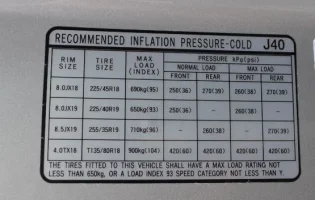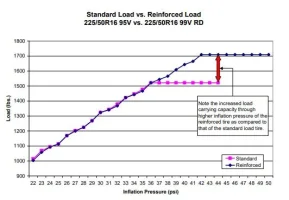rtv900
Active Member
- Joined
- Sep 11, 2021
- Messages
- 307
- Reaction score
- 112
- Points
- 43
seriously?Not for RWD, it's reversed from AWD. There are no AWD Stingers In Aus.
what the
do you have the staggered set up?

seriously?Not for RWD, it's reversed from AWD. There are no AWD Stingers In Aus.
If I'm not mistaken, the pressure needed in a tire is a function of the volume of the tire (i.e. the rim diameter and the cross-sectional area of the tire), coupled with the size of the contact patch, and the weight the tire/axle has on it.seriously?
what the
do you have the staggered set up?
Thanks for this! I'm no car expert, but it makes common sense to me that staggered tires (my first car with this setup) would have different pressures.If I'm not mistaken, the pressure needed in a tire is a function of the volume of the tire (i.e. the rim diameter and the cross-sectional area of the tire), coupled with the size of the contact patch, and the weight the tire/axle has on it.
For the staggered setup the rear tires have a larger cross sectional area than the fronts for the same diameter, meaning that they would need less pressure to achieve the same inflation level as the fronts assuming the same amount of weight was on them.
But they don't see the same amount of weight. RWD is missing the transfer case, front differential, and front CV's. Thus, it would make sense that the RWD's would need more pressure in the rear or equal pressure all around because the front axle in RWD would see comparatively less weight than the front axle in the AWD models.
Thus why it's always a good idea to check the placard on your specific car. I believe AWD vs RWD has a role, as well as 3.3 vs 2.0 vs 2.5; All of those engines have different weight and so they would affect the weight on the fronts.
No,With regard to 50 PSI when the Stingers were delivered, could that have caused this sort of cracking?
Not sure exactly when the happened, but I noticed it at about 8K miles. Kia dealer told me to take to any Michelin authorized dealer.
The guy at the tire shop said he had never seen anything like it. It was all 4 tires. All 4 tires were replaced under warranty.
This was about 3 years ago. I mostly remember 2 guys using a lot of 4 letter words to describe the situation. It's a shop here in LA, West Coast Tires, that we've used for 20 years to service multiple cars. Not just tires, but routine service. Most everything but recalls and other stuff that can only be performed by the dealer.No,
What did the tire shop tell you about the root cause? They must have had an opinion?


That is interesting. I suspected that there are other factors in play for a car like that, so I did some quick googling and came up with some fascinating tidbits here:my z06 has a perfect 50/50 weight distribution and calls for 30psi cold all around despite 335's in the back and 285's front
yeah I agree, that's why I sold them. They were however great in July/August weather on dry roads, but other than those two months they were not fun. I now have a set of summers and a set of snow tires for my Z06 also and I drive it all through winter if the roads are cleanI wouldn't run barely street-legal slicks like those on public roads, other than maybe drive to a local event on a sunny day. They are brilliant at what they do best, but they suck bad at what they aren't designed to handle. That's why we have as many sets of wheels/tires as we do.
CorrectNot for RWD, it's reversed from AWD. There are no AWD Stingers In Aus.
This is the truly correct answer, since so many factors go into what "ideal" pressure is. More work than most people are willing to do, but those temp guns are like $20. I wonder if there would be any apparent difference after, say, a 5/10 drive around town (vs. 9/10 at the track). Maybe I'll grab mine the next time I think about it.We bring a temp gun to gauge temp across the tire tread, but quite often the tires will tell you if they are happy with the set pressure or not.
I sincerely hope nobody is taking this advice seriously...Front 36
Rear 38
On every car not just Kias.
Has been for decades
I have a couple of infra-red temp guns that I use to check my A/C and report back to my HVAC guy.This is the truly correct answer, since so many factors go into what "ideal" pressure is. More work than most people are willing to do, but those temp guns are like $20. I wonder if there would be any apparent difference after, say, a 5/10 drive around town (vs. 9/10 at the track). Maybe I'll grab mine the next time I think about it.
I sincerely hope nobody is taking this advice seriously...
@Volfy may have better Stinger-specific advice, but in general I'd expect to see higher temps at center for overinflated, higher at edges for underinflated, and higher from one side to the other for excessive camber.I have a couple of infra-red temp guns that I use to check my A/C and report back to my HVAC guy.
If I wanted to use this to check my tire, what would I be looking for? Same temp center of tire vs outer edge? And what adjustment would I make?
Are you talking about measuring the rubber temperature after a hot lap at a track? Or measuring the rubber temperature after driving down a straight road for some minutes?I have a couple of infra-red temp guns that I use to check my A/C and report back to my HVAC guy.
If I wanted to use this to check my tire, what would I be looking for? Same temp center of tire vs outer edge? And what adjustment would I make?
Thanks!
